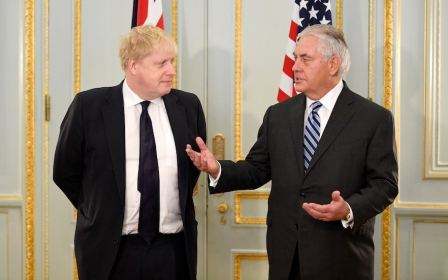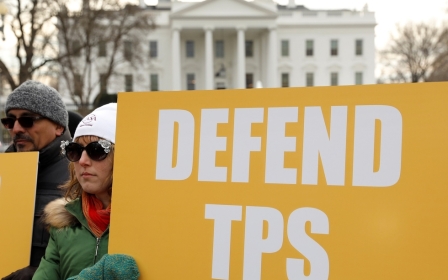Syria war: Civilians killed in government air strikes across rebel-held areas

Syrian government warplanes killed seven civilians and injured dozens of internally displaced people in Aleppo as air strikes and shelling intensified across rebel-held areas in Syria.
Several air strikes and artillery shelling also took place in Eastern Ghouta, a suburb of the capital Damascus, on Friday as concerns mounted over chemical attacks by the Syrian government.
Images posted by the Syrian Civil Defence Force (SCD), also known as the White Helmets, showed rescue volunteers helping refugees who were part of a convoy that was struck by the Syrian government in the village of Telahdiya in the West Aleppo countryside.
The air strike in Telahdiya took place hours after Syrian government warplanes killed three civilians in Arbin city in Eastern Ghouta on Friday afternoon. The SCD dispatched several rescue volunteers to help the wounded after government warplanes struck residential areas across the city.
We are even more concerned about the possibility of sarin use
- US Defence Secretary, John Mattis
The attack came minutes after artillery shells hit Douma city in Eastern Ghouta, which injured civilians. The SCD did not report any fatalities but said that its rescue operation inside Douma city was ongoing.
Images posted by the SCD showed volunteers rescuing a child who survived the government shelling in Douma. The SCD did not report any fatalities but said on Twitter that it continued to look for survivors inside Douma city.
Chemical attack concerns
On Thursday, a chemical attack was reported in Douma. This attack represents the third chemical attack in Eastern Ghouta since the start of 2018, with two earlier attacks on 13 January and 22 January.
US Defence Secretary Jim Mattis said on Friday that while he does not have evidence of the nerve agent sarin being used by the Syrian government, the United States was looking into reports about its use and was concerned.
Mattis, speaking with reporters, said the Syrian government had repeatedly used chlorine as a weapon.
"We are even more concerned about the possibility of sarin use ... I don't have the evidence, what I am saying is that other groups on the ground, NGOs, fighters on the ground, have said that sarin has been used, so we are looking for evidence," Mattis said.
His comments come after the Trump administration on Thursday said it would take military action against Syrian government forces to deter the use of chemical attacks.
Forces loyal to Syrian President Bashar al-Assad have continued occasional use of chemical weapons in smaller amounts since a deadly attack last April that drew a US missile strike on a Syrian air base, US officials told reporters.
A global campaign was launched this week to raise awareness about the successive chemical attacks that have taken place in Eastern Ghouta as Syrian government forces continue to fight to take control of the area.
Under the hashtag#DoumaSuffocating, people from across the world have been posting pictures of themselves placing a hand over their mouth to raise awareness about the chemical attacks.
Mohamad Katoub, an advocacy officer from the Syrian American Medical Society (SAMS), told Middle East Eye that two women and a 16-year-old child displayed symptoms indicative of chlorine from a suspected chemical attack on Thursday morning.
"Thankfully there were no fatalities from yesterday's attack, but medical staff from our facility inside Douma confirmed that two women and a 16-year-old girl displayed symptoms indicative of chlorine," said Katoub.
In late January, rescue workers in a rebel-held enclave east of Damascus said government forces had again used chlorine gas, and the Syrian Observatory for Human Rights said at least 13 people had suffered suffocation.
The White Helmets civil defence rescue force, which operates in rebel-held parts of Syria, said 13 civilians including women and children had been "injured after [the] Assad regime used chlorine gas in Douma city in Eastern Ghouta".
A UN body in October 2017 held the government responsible for a Sarin gas attack on a rebel-held town that killed more than 87 people.
"The panel is confident that the Syrian Arab Republic is responsible for the release of sarin at Khan Sheikhun on 4 April 2017," stated the report seen by AFP.
Images from the immediate aftermath of the attack drew global outrage and prompted the US to fire dozens of cruise missiles at a Syrian airbase where the gas was allegedly housed.
Middle East Eye propose une couverture et une analyse indépendantes et incomparables du Moyen-Orient, de l’Afrique du Nord et d’autres régions du monde. Pour en savoir plus sur la reprise de ce contenu et les frais qui s’appliquent, veuillez remplir ce formulaire [en anglais]. Pour en savoir plus sur MEE, cliquez ici [en anglais].




